From insider to investigator
August 2, 2013
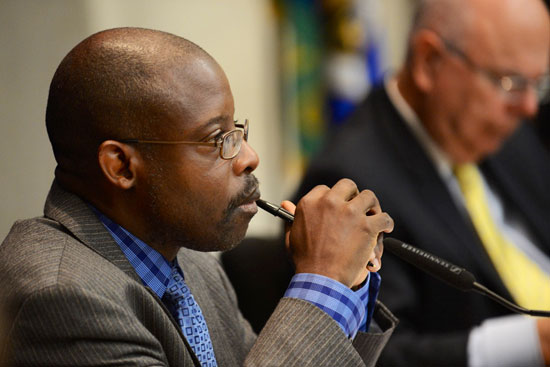
David Sanders, chair of the new child protection commission, says his DCFS years give him a unique perspective.
The director of Los Angeles County’s Department of Children and Family Services was on the hot seat. Social workers in the agency had failed to protect a young boy from the fatal blows of his mother, despite being aware of earlier abuse allegations against her.
“Let’s not kid ourselves,” Supervisor Gloria Molina lectured the agency’s director, who’d been summoned before the board during its weekly meeting. “This is about people not doing their jobs.” Molina demanded that the director act more forcefully to fire his “ill-trained” workers.
That kind of dressing-down easily could have occurred on any number of recent days, as the Board of Supervisors has confronted the death of 8-year-old Gabriel Fernandez, who was allegedly tortured by his mother and boyfriend after a long history of abuse complaints. But the case that triggered Molina’s ire came in early 2004. And the director was not the current boss, Philip Browning, but David Sanders, who resigned in mid-2006.
Among the many who’ve held the top position at DCFS, Sanders was the only one to leave without being shown the door by the supervisors, his reputation intact. Now he’s voluntarily back in a new high-profile job; on Thursday, he was selected as chairman of the Blue Ribbon Commission on Child Protection by his nine colleagues during the panel’s inaugural meeting.
Each of the county’s five supervisors appointed two members to the commission, which was created on a split vote of the board to investigate systemic failures in L.A.’s child protection system. Sanders, selected by Supervisor Mark Ridley-Thomas, is the only panelist with a true insider’s perspective on the pressures and dynamics within the huge agency entrusted with the welfare of nearly 35,000 children. (Click here for a look at the other appointees.)
“I know what it’s like to have a crisis come up and turn the department in another direction,” Sanders said by phone, while making a connecting flight in Denver to his home in Seattle, where he’s now an executive with a non-profit. He says he’s “acutely aware” of not placing unnecessary demands on DCFS that would distract the agency from its primary mission of protecting children. The commission’s examination, he says, will go far beyond DCFS to investigate the performance of the broader network of agencies with a role in child safety, from law enforcement to the schools.
Since DCFS’s creation in 1984, arguably no director has had a bigger impact than Sanders—one that continues to shape the agency’s philosophical and financial strategy towards both foster care and family reunification.
In the past, the agency would receive tens of thousands of dollars in state and federal funds for every child placed in foster care. Believing this created a financial incentive to remove at-risk youngsters from their families, Sanders championed what he described at the time as “a revolutionary” funding model in which the agency would receive a flat amount to spend not only on foster care but on new services and programs to keep families together.
The so-called waiver, which took effect in 2007, has been widely praised for dramatically reducing the number of children in foster care. But in recent years concerns have surfaced over whether this shift in funding has created another kind of incentive, keeping kids in potentially dangerous family situations so DCFS can use the money it saves on foster care for other departmental priorities.
Asked how he’d approach having to investigate the impact on DCFS of one of his greatest legacies, Sanders said: “I don’t feel reluctance to attack any policy that isn’t relevant to the circumstances today…I don’t think anything is sacred, whether it was stuff I thought was important 10 years ago or today. My belief is that there is a fundamental responsibility to assure children are safe.”
Although it’s been seven years since Sanders’ departure, he says he still works closely with his former agency—one that he’s now expected to approach as an independent fact-finder.
Sanders is an executive vice president of the Seattle-based Casey Family Programs, founded in 1966 to focus on foster care and improving child welfare systems throughout the country. He says the non-profit organization has “done a number of initiatives with the county,” including helping Browning and other DCFS officials rewrite the agency’s policy manual. “I have a passion for the work in Los Angeles,” he says.
Sanders says his selection as chairman of the child protection commission was “very humbling,” especially considering “the incredibly impressive group” that’s been assembled by the Board of Supervisors. He says the commission “isn’t going to tolerate a repeat” of earlier investigative efforts in which recommendations for reform went unheeded.
“This,” he says, “is a group that is going to be very action oriented.”
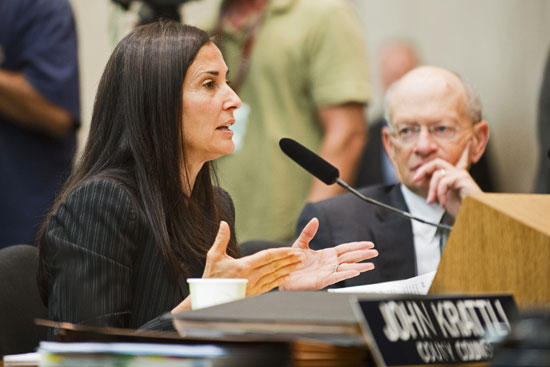
Child advocate Leslie Gilbert-Lurie and retired Judge Terry Friedman were appointed by Supervisor Yaroslavsky.
Posted 8/2/13
A breakthrough for vets
August 2, 2013
A few years ago, I was participating in the county’s biannual homeless census when I came upon a man sleeping under a bush on La Brea Avenue. It was winter, about 4 a.m. The man had been on the streets for ages. He shivered awake, and we talked for a few minutes, his breath steaming the night air, his clothing disheveled. Among other things, he told me he was a veteran.
That conversation was as heartbreaking as it was emblematic. More than 6,000 of Los Angeles County’s homeless are former military servicewomen and servicemen. Once, they volunteered to give their lives for their country. Now they wander our streets, their minds and bodies often addicted or damaged, their chances higher than average of ending up in the ranks of long-term street people at massive public expense.
That’s why, two years ago, we partnered with the Department of Veterans Affairs to launch a pilot program, a spinoff of our successful Project 50, to provide permanent supportive housing for a group of veterans identified as most likely to die on the streets.
There were 60 to start, severely mentally ill and chronically homeless. And, as with Project 50 on Skid Row, our veterans initiative, dubbed Project 60, started with the premise that if you give someone housing first—no moralizing, no demanding that they get a job or sober up as a condition of shelter—they’ll be more amenable to any medical, mental health or substance abuse treatment services you offer. That, in turn, will spare taxpayers the much higher cost of housing them in hospitals and jails.
It was a novel idea, and today, I am thrilled to report that it has paid off.
This week, during a meeting in Washington, D.C., with U.S. Sen. Dianne Feinstein, Rep. Henry Waxman and myself, Secretary of Veterans Affairs Eric Shinseki committed to dramatically scaling up the program, which, according to this year’s homeless census, contributed to a stunning 23% drop in the number of homeless vets over the last two years in Greater Los Angeles.
The VA’s commitment—part of the Secretary’s long-stated goal of ending homelessness among veterans by 2015—will fund and support a sweeping expansion of homeless services for veterans in L.A. County, from housing vouchers to medical outreach to a dedicated homeless services center at the West Los Angeles VA facility.
In all, it will allow us to house and treat more than ten times as many homeless vets in the next two years as we did over the last two. During this period, we expect to house 1,320 chronically homeless veterans. This represents the single most significant development on this issue in years.
It’s also the result of a lot of hard work and collaboration by Sen. Feinstein, Rep. Waxman and staff including Donna Beiter, who directs the VA’s Greater Los Angeles Healthcare System, the VA’s Michelle Wildy, Flora Gil Krisiloff in my office, Mary Marx with our county Department of Mental Health and front-line nonprofits Ocean Park Community Center in Santa Monica, St. Joseph Center in Venice, San Fernando Valley Mental Health Center and the Hollywood branch of Step Up on Second.
And it’s proof that when we build on our successful programs, we can make a life-saving difference. We have helped nearly 120 homeless mentally ill veterans through our original Project 60: a sailor who spent the past 15 years sleeping in a Santa Monica park and making monthly emergency room visits until he got housing; a former Marine who, after a decade, has begun to get sober in her Gardena apartment; a Vietnam vet, dying of cancer in a hospice, who came in from the night in time to make peace with his anguished family. Now the number being cared for will dramatically increase.
These veterans answered the call of our country when we needed them. Now they need us, and this week marks a huge breakthrough in helping Los Angeles answer that call.
Posted 8/3/13
Beyond “Baywatch”
August 1, 2013
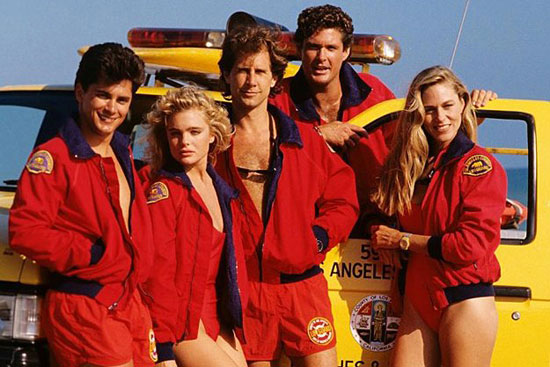
“Baywatch” made county lifeguards into global sex symbols—and made them leery for years about celebrity.
The Los Angeles County Fire Department is rarely surprised when Hollywood comes knocking. After all, their firefighters and lifeguards have some of the more exciting real-world jobs here in Tinseltown.
But for more than a decade, the department has shied away from film depictions.
“Our image is very important to us,” says Capt. Thomas Richards of the department’s public information unit. And, he says, shows like “Baywatch”—which turned L.A. County lifeguards into global eye candy in the 1990s—left county taxpayers, as well as some lifeguards, feeling burned.
Now, however, the department is dipping a cautious toe back into the show biz waters with a proposal to streamline the approval process for film requests.
Scheduled for consideration next week by the Board of Supervisors, the plan would let the department contract on its own with film production companies to do the limited filming necessary to create TV pilots, “sizzle reels” and other supporting material for pitches to the county.
The idea, Richards says, is to give fire officials—and ultimately the Board—a fuller sense of how county employees might be affected by or depicted in a proposed film or series while easing the frustration of producers, who often get a flat “no” from the department or wait weeks or months for an answer. Such filming would not be for public consumption, and the Board would retain final approval for any use on film of the department’s image, personnel, facilities or equipment.
“If we can show firefighters and lifeguards in a positive light, that’s a good thing, and these requests come to us all the time,” says Richards. But, he says, the current approval framework can be cumbersome and lengthy, and the requests are often time-sensitive.
That’s an understatement, says Bud Brutsman, chief executive officer of Brentwood Communications International, Inc., a North Hills production company that came to the county six months ago with a request to film county lifeguards for a reality show proposal featuring Venice Beach.
Brutsman says the show, operating under the working title “Venice 24/7”, has been commissioned by the Travel Channel as a West Coast spinoff of its successful “Airport 24/7: Miami,” a reality show about Miami International Airport. “The concept is to follow all aspects of the city—police, HazMat guys, lifeguards. For Venice, it’s a very positive thing.”
As part of the deal, he says, he has to shoot a so-called “sizzle reel”—a 2-to-3-minute collection of scenes that functions both as a preview and as proof that the producers have the access to generate a whole series. To do this, he has had to seek permission to film from both the City of Los Angeles and the county, which share responsibility for the community’s various municipal services.
But while the city services were shot in a matter of weeks, he says, he’s still awaiting permission from the county, which provides the community’s lifeguards.
Richards says that’s partly because the department decided to seek the policy change before responding. But, he says, decisions on filming, even for small proposals, currently require Board approval, which can be time-consuming.
The department spokesman adds that county lifeguards actually like the Venice project, viewing it as an opportunity to show real people performing a real public service. That’s a far cry from the way the department has viewed past TV depictions.
“Baywatch was very successful—for the producers of Baywatch. And that’s something that still comes up,” says Richards, noting that little revenue from the series ever found its way into county coffers, and that lifeguards came away feeling objectified by the show’s slow-motion scenes of god- and goddess-like actors loping down local beaches.
“Our lifeguards are the best in the business,” he says. “And the county got very little from that experience.”
Brutsman, the producer, hopes to convince the department that his show will be different. Still, he notes, delays and distrust just make it harder to do show business in the industry’s backyard.
“I gotta bear the cross for Baywatch?” he jokes. “”Hey, I didn’t like that show either! But if it helps, we can leave our slow-mo camera at home.”

A proposed reality show about Venice Beach has been waiting for months to shoot a 3-minute “sizzle reel.”
Posted 8/1/13
Ramp Jam? Oh, never mind
August 1, 2013
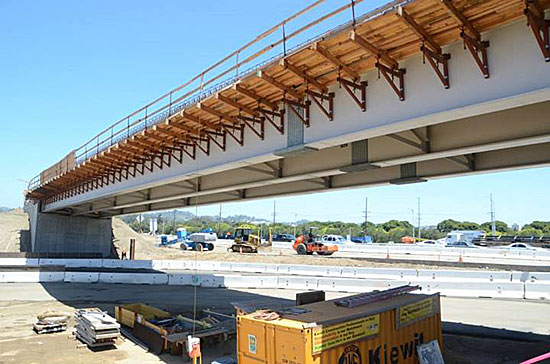
This flyover ramp, photographed in May, is part of the Wilshire segment nearing completion. Photo/Metro
Remember the epic closure of the Wilshire Boulevard ramps to the 405 Freeway, heralded as “Ramp Jam” and “The Rampture” and promising long-running, round-the-clock closures of eight ramps at one of the nation’s busiest intersections?
With three of the new ramps now completed and a 90-day closure set to begin this month to finish a fourth, Metro says that extended shutdowns of the remaining ramps won’t be needed after all.
The new plan, to complete all of the ramp work with only half of the pain by the end of this year, is an upbeat development in a project that’s been beset with deadline and cost issues. The project as a whole, which is adding a new 10-mile northbound carpool lane and other improvements to the 405, is currently expected to be virtually completed by mid-2014.
The final 90-day Wilshire ramp closure—of the eastbound Wilshire on-ramp to the northbound 405—is set to begin August 22. It represents the last shutdown of its kind required to complete the ambitious Wilshire ramp portion of the project, although intermittent nighttime closures will take place to finish the job. The new Wilshire configuration includes sweeping flyover ramps and safer, faster-moving lanes to separate entering and exiting traffic.
In addition, project officials have determined that previously scheduled long-running closures of the Santa Monica Boulevard on- and off-ramps to the 405 will no longer be needed. Those closures had been expected to last between 7 and 14 days.
At UCLA, where foreboding about Ramp Jam had run high, there was a sense of pleasant surprise about how things have turned out.
“It’s definitely been better than we expected,” said Renée Fortier, UCLA’s executive director of events and transportation. “And we really appreciated the flexibility of Metro in working with us to make sure that the ramp closures worked with some of the special events that we’ve had.”
“Compared to the Sunset ramp closures, we’ve heard hardly any complaints,” she added. “It has actually gone pretty smoothly and we haven’t heard a whole lot from the UCLA community.”
Keeping the existing eastbound Wilshire off-ramp from the northbound 405 open while the new one was under construction proved to be a crucial decision in terms of keeping traffic moving smoothly to the campus, said Dave Karwaski, UCLA’s senior associate director for planning, policy and traffic systems. That’s because 33% of the university’s employees come from the south—the largest single geographic cluster—making that off-ramp key to the morning commute, he said.
Kasey Shuda, the Metro construction relations manager on the project who appeared in this video last year to explain the extensive Wilshire ramps work, said that the original predictions of long-running closures on multiple ramps had been set aside once detailed design and work plans had been completed. Officials decided that only the northbound ramps needed to be constructed from scratch; the southbound ramps are being improved and modified but don’t require complete rebuilding. And the end is in sight.
“Three out of four flyovers are open,” Shuda said. “We’re pretty close to finishing now.”
As for the project as a whole, there’s still plenty of work—and disruption—ahead. Starting Saturday, August 3, for example, the Sunset off-ramp of the northbound 405 is closing for 120 days.
Since construction started in 2010, the 405 Project has dished up two Carmaggedons that went off without a hitch and a Ramp Jam that never really materialized, along with countless less-publicized detours, closures and daily annoyances. Understandably, a certain fatigue has set in.
At UCLA, Fortier said, “I think that people would like it to be over already.”
Posted 8/1/13
Sunset off-ramp to close for 4 months
July 25, 2013
Say so long—for a long time—to the Sunset off-ramp to the northbound 405 Freeway. Starting Aug. 3, the ramp will close for 120 days, adding another level of complication to one of the region’s longest-running construction zones.
The closure will enable construction workers to create a longer, better configured off-ramp as part of the 405 Project, which also includes a 10-mile northbound carpool lane along with other improvements. As it currently stands, the work isn’t expected to be finished until Nov. 30, two days after Thanksgiving. Metro’s list of suggested detours is here.
A big impact of the Sunset ramp closure will be on morning commuters to UCLA. An estimated 800 motorists an hour travel the ramp during the peak morning travel time.
It’s not the only long-term ramp closure scheduled to hit this summer. The eastbound Wilshire Boulevard on-ramp to the northbound 405 will also be closing, for 90 days starting August 22.
“The traffic issues will be in completely different areas,” said Kasey Shuda, construction relations manager for the project, adding that officials will be evaluating how the two closures affect traffic flow and have contingency plans to put in place should they be needed.
Adding to the overall pain, Sepulveda Boulevard—a popular alternative to the 405—also closes most nights for construction work, although it remains open during the daytime.
In the slightly better news department, project officials said they’ve installed 5 new and more visible message signs to make it easier for motorists to see at a glance which ramps are closing ahead for overnight work. Those nightly ramp closures are in addition to the upcoming long-running closures of the Wilshire and Sunset ramps.
Posted 7/25/13
Another hard look at DCFS
July 25, 2013

A blue ribbon panel will investigate the vast network of agencies responsible for keeping children safe.
An independent commission created as Los Angeles County’s latest effort to keep children safer in its sprawling child welfare system took final shape this week, as the Board of Supervisors named the last four appointees, ranging from child advocates to the former head of the county’s juvenile court.
The appointments to the Blue-Ribbon Commission on Child Protection rounded out a 10-member panel established after the May 24 death of Gabriel Fernandez. The 8-year-old Palmdale boy was left by social workers in the care of his mother and her boyfriend despite multiple reports of abuse, neglect and torture.
The mother and boyfriend are being held on murder charges and several employees have been placed on desk duty pending results of an internal investigation at the Department of Children and Family Services.
In the wake of that case and others, however, a majority of the supervisors also believed that that the child protective system needed a deeper examination by an independent investigative body modeled after the Citizen’s Commission on Jail Violence, which last year recommended reforms after disclosures of deputy brutality in the county lockup.
Former DCFS Director David Sanders, appointed by Supervisor Mark Ridley-Thomas, said in an interview that the panel will have a broad mandate to investigate the network of agencies that interact in the child welfare system, including law enforcement and schools.
“This is a full, countywide, responsibility and not just a DCFS responsibility,” Sanders stressed in an interview. “What’s most critical is to understand very specifically how many children are being seriously injured due to abuse and neglect. What are the numbers of fatalities? How many children are being re-injured after they come to the attention of the agency? And how can the county improve safety for children?”
Retired Judge Terry Friedman, appointed by Supervisor Zev Yaroslavsky, said the panel will need to distinguish itself from earlier investigations that have led to management shakeups and hundreds of recommended reforms.
“It’s something we need to address—are we different or are we just the next installment of a longstanding litany of good-intended efforts?” Friedman said. “And if not, how do we approach this issue differently?”
One challenge the commission will face, he added, is the belief that, with the right set of solutions, child deaths can be halted altogether in a system as big and complex as Los Angeles County’s.
“That isn’t to say we can’t make it less likely,” said Friedman, whose 15 years on the bench included stints as the supervising judge for the juvenile dependency court and presiding judge for the juvenile court.
“But realistically, the challenges are so embedded in our society that the best one can hope for is to recognize possibilities and limitations and be realistic in order to make some progress, rather than pretending that perfection is possible.”
Friedman was named to the panel on Tuesday, along with Leslie Gilbert-Lurie, a founding board member and past chair of the Alliance for Children’s Rights and a former member of the Los Angeles County Board of Education, and Janet Teague, who has served both on the Alliance board and on the Los Angeles County Commission for Children and Families. Also appointed this week was Gabriella Holt, a former member of the Los Angeles County Board of Education and a current member of the Los Angeles County Probation Commission.
Like Friedman, Gilbert-Lurie was appointed by Yaroslavsky. Supervisor Don Knabe appointed Holt and Teague.
The four completed a series of earlier appointments that included:
- Marilyn Flynn, dean of the USC School of Social Work, appointed by Ridley-Thomas.
- Richard Martinez, a former foster youth who is superintendent of the Pomona Unified School District, and Andrea Rich, former president of the Los Angeles County Museum of Art, both appointed by Supervisor Gloria Molina.
- Dan Scott, a recently retired veteran of the Sheriff’s Department’s Special Victim’s Bureau, and DickranTevrizian, a retired U.S. District Court judge, both appointed by Supervisor Michael D. Antonovich.
Among the more intriguing picks was Sanders, who oversaw DCFS from 2003 until 2006. Now based in Seattle, he left to become executive vice president of systems improvement for a national foundation specializing in foster care, the Casey Family Programs.
Since his departure, the department has had five directors and acting directors, with the latest turnover occurring last year, when veteran county executive Philip Browning agreed to take over. Browning—who had overhauled the county’s child support efforts and the Department of Public Social Services—was implementing a new strategic plan and training curriculum at DCFS when the Fernandez death was disclosed.
“It’s a tough job,” Sanders said, adding that he hopes the commission will focus on the big child protective picture “rather than interfere or kind of rehash issues that have been examined multiple times.”
“The demands on the department can be quite daunting,” he added. “But I think Phil is somebody who has a lot of experience in the county, and I hope the commission can augment his work and take some of the pressure off him for issues that are really countywide.”
Posted 7/25/13
A new river runs through it
July 25, 2013
For most longtime Angelenos, the Los Angeles River has represented little more than a concrete scar across the county, a channel sending urban runoff and debris towards the sea. Although largely justified in the past, that perception has failed to keep pace with the river’s emerging new realities and its potential to become one of the grandest urban greenways in America.
There was a time when the Los Angeles River was a lifeline for our region. Along its banks, the Gabrielino Indians hunted, fished and lived. The Spanish established the city’s earliest settlements on the river, which would later power the area’s industrial growth. But by the early 20th Century, the river simply could no longer co-exist with the Los Angeles Basin’s explosive growth. A deadly flood in the winter of 1938 finally led to its encasement in concrete, paving the way for the river to become more famous as a backdrop for movie car chases than for its real-life story.
To be sure, long stretches of the river’s 51-miles remain as barren today as they did a quarter-century ago. But elsewhere, a rebirth has been taking root like the lush foliage that again blankets the riverbed between downtown L.A. and Griffith Park. In fact, through a burgeoning public-private partnership, a reimagining of the river’s place in modern-day Los Angeles is gaining unprecedented traction.
President Obama recently made the rejuvenation of the L.A. River a top priority in his urban waterways initiative. And with the federal government’s earlier recognition that the river should be open for recreational use, higher water quality standards are also on the way.
The City of Los Angeles, along with the county and other municipalities, has built miles of new bikeways along the river. In April, NBCUniversal committed nearly $14 million toward the completion of a 6.4 mile gap between Griffith Park and Studio City. Pocket parks also are sprouting on the river’s banks. A summer pilot program has people from across the region kayaking and fishing in its Glendale Narrows passage. And this week, we celebrated the public and private support that will soon give rise to La Kretz Crossing—a stunning pedestrian, equestrian and cyclist bridge near Atwater Village.
But all this is only a start in turning the river into a truly vibrant public space, where our diverse population can not only share recreational opportunities but also forge a broader sense of community from the valley to the ocean. In one of the nation’s most densely developed regions, the Los Angeles River represents a unique opportunity to transform blighted infrastructure into a scenic refuge—a quintessentially L.A. version of New York’s hugely popular “High Line,” a mile-long aerial park built along old railroad tracks.
That’s the charge of Greenway 2020, an initiative spearheaded by the non-profit Los Angeles River Revitalization Corporation, which has an immediate goal of completing all 51 miles of the river bikeway by the end of this decade. Filling in gaps totaling 24 miles through government and private financing, the path would extend from the west San Fernando Valley to Long Beach, complete with amenities such as bike shops, eateries and picnic sites.
Daily commuters would be able to ditch crowded roads and buses in favor of a beautiful—and healthy—bike to work. The 100,000-plus cyclists who’ve turned out for the street-closing CicLAvia events is proof of the pent-up demand for bicycle experiences that don’t compete with automobiles. Entire families, meanwhile, would have a desperately needed getaway in our concrete landscape to play, to breathe and to build memories.
Every world-class city has public spaces that define it. But these monuments to urban life don’t build themselves. Communities come together to create them, and such will be the case for Greenway 2020. It will require coordination and commitment among L.A.’s community leaders, its governmental agencies and its private sector, including business and property owners along the river.
Most of all, it will require a grassroots movement to prove that Los Angeles is ready to make this vision a reality. We urge you to get involved – sign up at larivercorp.com to join Greenway 2020’s effortsand learn more about the project. Attend community meetings. Convey your support to your elected officials. Participate in L.A. River cleanups. Bike and kayak with your friends.
And help us chart a course for the river that will, once again, let it nourish life across Los Angeles.
This piece was co-authored by Allan J. Abshez, board member of the Los Angeles River Revitilizaton Corp.
Posted 7/25/13
Bridging the equine divide
July 25, 2013

La Kretz Crossing will represent a gateway for equestrians and a symbol of the L.A. River's restoration.
The Los Angeles River, it seems, is no place for horseplay.
For some two decades, equestrian advocates have pushed for a bridge over the river to connect the stables of Atwater Village to the trails of Griffith Park. The only alternative has been to ford the shallow river, a bit of tricky navigation even for skilled riders because of the slick, algae-covered rocks beneath the surface.
“The horses look like they’re on roller skates, their legs going in all directions,” says longtime rider Lynn Brown, a member of the City of Los Angeles’ Equine Advisory Committee. “Almost no one who keeps horses on the Atwater side crosses the river. It’s so dangerous.”
But that’s about to change. Real estate developer and philanthropist Morton La Kretz has ridden to the rescue, donating nearly $5 million for a strikingly-designed bridge that will allow equestrians, pedestrians and cyclists to cross the water north of Los Feliz Boulevard. Maybe just as important, officials say, the 300-foot-long La Kretz Crossing—with a towering support structure visible from the adjacent 1-5 Freeway—will signal to broader L.A. that the river’s renaissance is for real.
The construction of the bridge, scheduled for completion by the end of next year, is being overseen by the non-profit Los Angeles River Revitalization Corp., created by the City of Los Angeles to bring together public and private donors to transform the river into one of the nation’s premiere urban playgrounds. In fact, as part of the publicity surrounding La Kretz Crossing, the group this week announced the launch of Greenway 2020, an ambitious initiative to finish all 51 miles of the L.A. River bikeway by decade’s end, complete with such amenities as picnic sites, eateries and bike shops.
In addition to La Kretz’ donation, the bridge is being underwritten by contributions from the city and an allocation of more than $300,000 by Los Angeles County Supervisor Zev Yaroslavsky from voter-approved parks and open space funds.
Designed by the structural engineering firm of Buro Happold, the bridge will be divided with pedestrians and cyclists sharing one side and equestrians on the other. There’ll be a rubberized surface so the horses don’t slip and an eye-level fence to keep them from getting startled by passing cyclists. On the river’s western bank, the bridge will intersect with the bikeway, where equestrians and hikers can access Griffith Park’s trails through an existing tunnel under the freeway.
La Kretz was brought into the fold by renowned landscape architect Mia Lehrer, who says she got to know him while doing work for the environmental organization TreePeople; La Kretz’s name adorns the group’s educational Urban Watershed Garden in Coldwater Canyon. Lehrer says the elderly La Kretz, an avid cyclist, knew she was involved with the river’s restoration and said: “Give me something I can get excited about—and it has to be done while I’m still around.”
Soon, Lehrer says she and the river corporation were pitching the idea of a new bridge, the first that would be built in more than two decades and that would symbolically represent “a gateway” for the reimagined river. “He loved it,” says Lehrer, whose firm is the project’s landscape architect.
And La Kretz wasn’t alone in his enthusiasm.
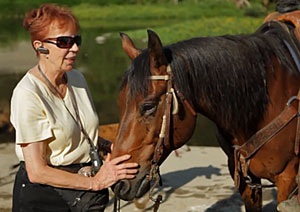
Equestrian advocate Lynn Brown has been pushing for years for a bridge between Atwater Village and Griffith Park.
“When I heard it was going to be built I was like, ‘Yay!” says Javier Del Angel, manager of The Paddock, an upscale, 200-horse stable along the river’s eastern bank in Atwater. He says he and his horse have tumbled twice trying to negotiate the crossing. “It was very scary, and I’ve been riding my entire life.”
Some years back, Del Angel says, a woman hit her head and was in a coma for three months. On another occasion, a horse had to be airlifted out of the river after slipping on the rocks. “His legs just gave out,” Del Angel recalls, adding that a few weeks later, the animal had to be put down.
With La Kretz Crossing providing easy access to the park, Del Angel says he now sees not only safer passage but also new financial opportunities: “I’m thinking about opening a new horse rental business,” he says.
Equestrian advocate Brown also calls plans for the new bridge “a huge deal.” Like Del Angel, she too has stories of river mishaps, including one just last year while helping the L.A. River Revitalization Corp. with a video for its website. The organization said it wanted footage of horses in the river, so Brown recruited the president of the L.A. Equine Advisory Committee, who brought along an extra horse to lead through the water. Before the filming began, she says, the riderless horse stumbled and fell.
Frankly, Brown says, she was “utterly stunned but pleased” that she was even asked to participate in the video in the first place. She said that, for years, the safety and access concerns of the equestrian community seemed to go unheard.
“We thought it was a lost cause,” she says. “I’m happy to be wrong.”
Amid all the hoopla, however, one horseman offered some words of caution.
Tony Lomedico is a lieutenant with the Los Angeles Police Department’s Mounted Unit, which is based along the river in Atwater Village. He acknowledged that the bridge will enhance safety for novice riders but expressed reservations about how some horses might react to being so close to cyclists, calling it a “new sensory experience” to which they’ll have to get accustomed.
“We look forward to the bridge coming,” Lomedico says, but “I think it’s going to create some challenges.”
Posted 7/25/13
Hot home sales fuel record tax roll
July 25, 2013

As home sales boom, at least for now, the county's property tax roll is hitting new heights. Photo/L.A. Times
As Los Angeles’ housing market recovery moves from anemic to heated, county coffers are reaping the benefits of a record-setting, nearly $1.130 trillion property tax roll—more than $50 billion bigger than last year’s.
But thousands of homeowners whose taxes went down when the assessed value of their properties plunged during the recession are catching an upward wave, too. That means higher tax bills for 196,200 property owners, who’ll be forking over an average of $820 more in property taxes this year.
The rise in values isn’t universal: some 121,800 properties that declined in assessed value are staying at the same level this year, while 50,600 properties are experiencing further reductions.
But overall, the trend is positive, with this year’s 4.66% increase in the county tax rolls representing a marked improvement from the 1.49% and 2.24% increases in the previous two years. The upswing reflects a hot market for real estate in many parts of the county, with once dismal home prices rebounding in a big way.
“Strength in the residential real estate market was the largest single factor for the increase in roll value,” Chief Deputy Assessor Santos Kreimann said in a statement.
Assistant Assessor George Renkei added: “In addition to closing the roll at a new record level, we are proud of the accuracy of this year’s forecast as well as the other substantial improvements that were developed and implemented over the past twelve months.”
Even as “SOLD!” increasingly replaces “Bank-owned” or “Foreclosure” on local real estate signs, there are limits on how much a rising market can help the county’s bottom line. Under Prop. 13, property tax increases are tied to the Consumer Price Index and capped at 2%. Most of the time, it’s an uphill progression that allows the county’s tax roll to grow even when individual home prices are in the doldrums. But it’s a testament to how bad things were during the recession that in 2010, the CPI entered negative territory, posing interesting questions for the Assessor’s Office. It had to determine whether, by the law, property assessments would stay level or reflect the CPI’s dip. After consulting with the state Board of Equalization, the assessor granted a .237% reduction to all the eligible properties in the county. Since then, the adjustments have been in positive territory: less than 1% in 2011, 2% in 2012, and 2% again this year.
Property taxes represent a major part of the county’s budget, and the 4.66% increase that pushed the roll to its highest level ever this year translates to an estimated $180 million more in the county’s general fund.
Such increases are welcome news for the county’s budget—but small potatoes compared to the potential infusion that the county will realize when thousands of properties that haven’t changed hands in decades eventually are sold and their values adjusted to current market levels.
Prop. 13 rolled back property assessments to 1975-76 levels until a property is sold, when the new value is allowed to adjust upward. While the vast majority of L.A. properties have changed hands at least once since 1981, 362,710 of them haven’t, representing 19% of the parcels in the county, according to an analysis by the county’s Chief Executive Office. The “stored value” in those properties represents a potential multimillion dollar infusion for the county’s general fund when they’re sold in the years to come.
Posted 7/25/13




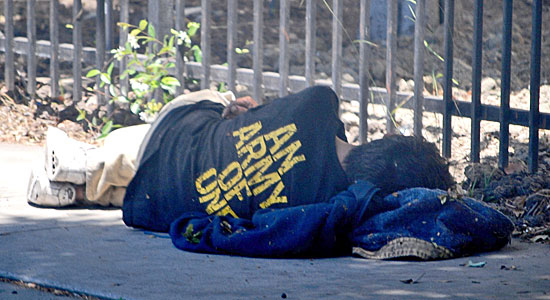



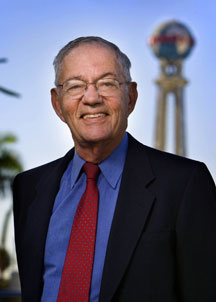






 Check for the latest closure information
Check for the latest closure information








